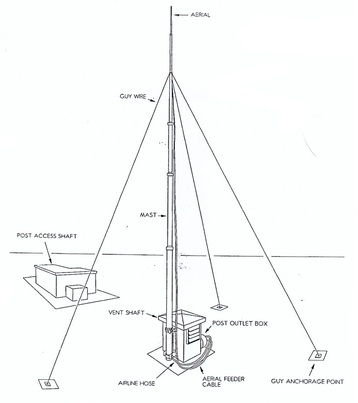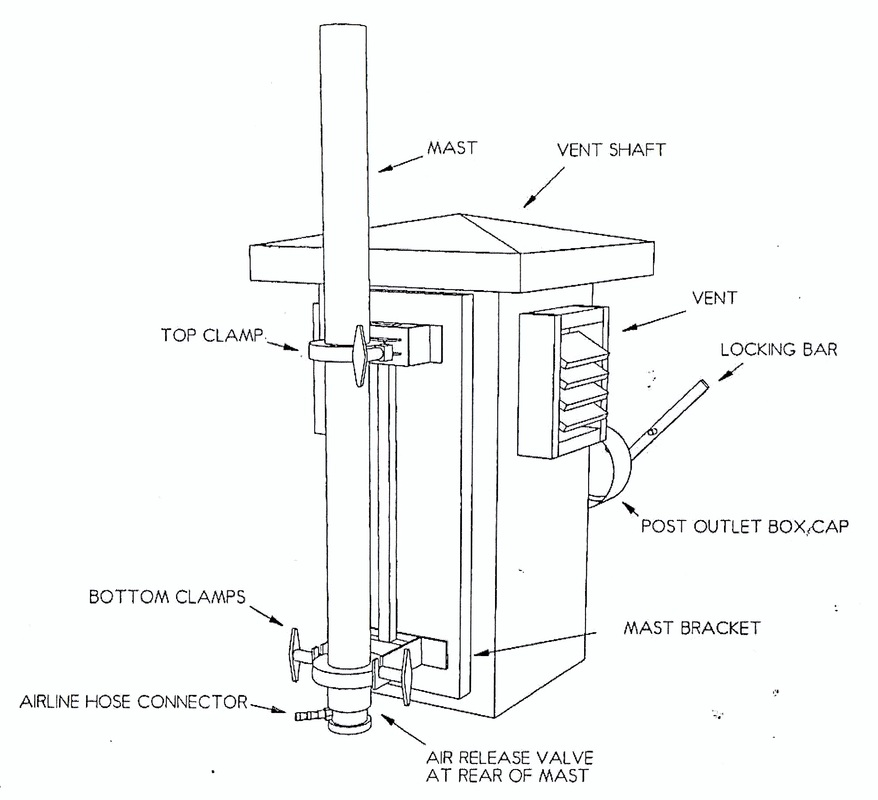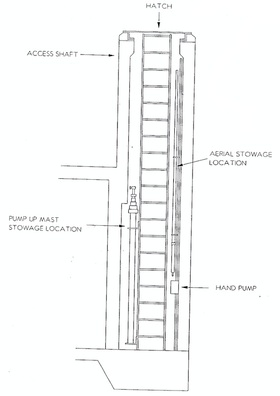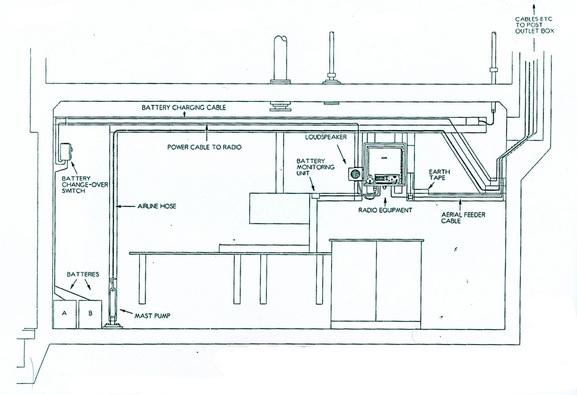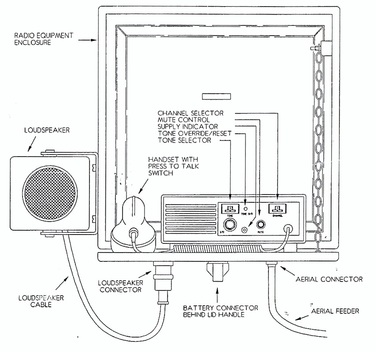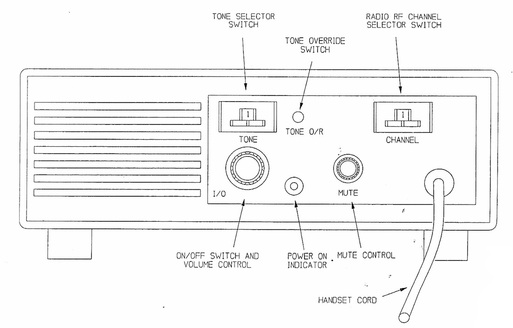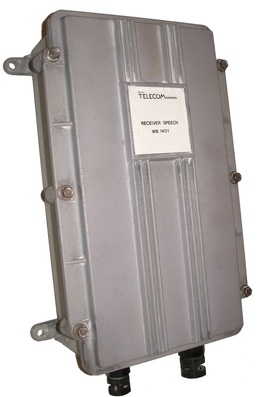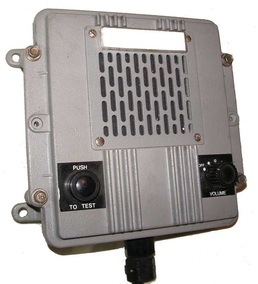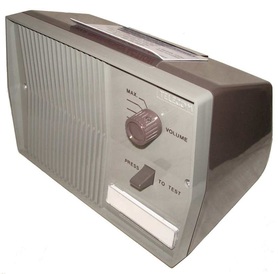LOUDSPEAKER TELEPHONE
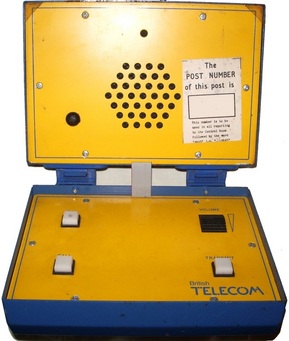
British Telecom Loudspeaker Telephone (AD8010) introduced c.1982
The Loudspeaker Telephone (aka "Tele-Talk" or AD8010) was introduced into the Underground Posts in 1964 after successful trials were undertaken within the Yeovil Group of that year. The early tele-talk was a small grey box that was approximately 20cm x 20cm and contained a microphone and amplifier very much similar to the telephone. The later tele-talk was of a bright blue and yellow 'clam-shell' design and was introduced circa 1982 (See Photo)
Like the telephone the tele-talk was line powered and therefore required no batteries or mains power connections. All that was required was therefore a standard telephone line accessing into the monitoring post. The unit was connected to the line via an 8-way line cord comprising a transmit, receive, power and signal pairs. The tele-talk allowed communication between the underground monitoring post and group control for the transfer of radiation and nuclear burst information.
Like the telephone the tele-talk was line powered and therefore required no batteries or mains power connections. All that was required was therefore a standard telephone line accessing into the monitoring post. The unit was connected to the line via an 8-way line cord comprising a transmit, receive, power and signal pairs. The tele-talk allowed communication between the underground monitoring post and group control for the transfer of radiation and nuclear burst information.
MONITORING POST RADIO
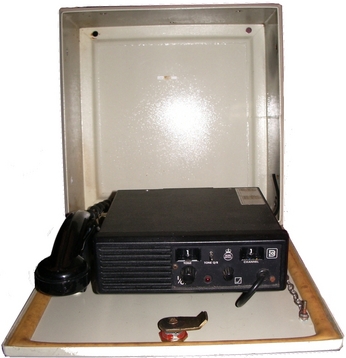
Burndept BE525 Monitoring Post Radio
In many cases it is believed that in the event of a nuclear explosion connections to the tele-talk may be lost due to the collapse of telegraph poles carrying the telephone wires. As a result it was decided that one underground monitoring post withen their custer of 2, 3 or 4 posts should be fitted with VHF radio. These posts which were known as 'master posts' utilised a pump-up mast that was attached to the outside of the monitoring post with an antenna cable accessing into the post via the ventilation shaft of the post.
In the chaotic situation following a nuclear attack, it was hoped that sufficient landlines would remain between posts for the master post to be able to report two or more fall-out readings through to the centre. The first trials with radio were carried out in the Winchester Group in the autumn of 1961.
In the chaotic situation following a nuclear attack, it was hoped that sufficient landlines would remain between posts for the master post to be able to report two or more fall-out readings through to the centre. The first trials with radio were carried out in the Winchester Group in the autumn of 1961.
Radio Setup Schematics
| Operation of Post Radio | |
| File Size: | 2315 kb |
| File Type: | |
AIR ATTACK WARNING SYSTEM (HANDEL)
The United Kingdom Warning and Monitoring Organisation was created in 1957 to provide warnings to the public of potential air attack and any subsequent risk of nuclear fallout from nuclear weapons. The system used to convey these warnings to the public was known by the keyword HANDEL. Prior to the introduction of HANDEL in the early 1960's, air raid sirens were controlled from local police stations using GPO landlines. The HANDEL network was installed during the early 1960’s and served until the end of the cold war and was configured to form two integrated parts,
- WB400 speech broadcast system
- WB600 siren control system.
During the early 1980’s the original equipment was replaced by the new WB1400 system using more modern technology and addressing the shortcomings of the previous one. It continued to use the same carrier frequency so the two could work together during the changeover period.
Air Attack Warnings
Air attack warnings were passed from Northern Radar System (NORAD) in Colorado, USA; Ballistic Missile Early Warning System (BMEWS) at Fylingdales, North Yorkshire and RAF Sector Controls through to the Primary War HQ (PWHQ). Simultaneously the warnings was sent through to the BBC Central Control for radio broadcast. The air attack warning would have been also distributed by land-line broadcast system to some 250 Carrier Control Points (CCPs) installed in major police stations throughout the UK. The Carrier Control Points would immediately issue a warning message to all Carrier Receivers which would notify the following groups of imminent attack.
The WB1400 Carrier Receiver was connected to the Post Telephone circuit or, in the case of ROC Controls, to one of the BT exchange lines. The receiver received the signals and spoken messages from the Carrier Control Points which were transmitted at a very high frequency and filtered out of the normal speech traffic of the telephone system.
Speakers (see below) located within the underground monitoring posts would have emmitted a constant "blip blip blip" when in operation. When a potential incomming attack on the UK would have been identified, the sound would change to a wail would have been emmitted from the speaker and speech warning of an "Attack Warning Red" would have been broadcast.
Above: Carrier Receiver box.
Below: Carrier Speaker. The speaker on the left is the armoured and waterproofed monitoring post version while the speaker on the right is the speaker used within sites such as hospitals, police stations, ambulances stations, coastguards etc.
Below: Carrier Speaker. The speaker on the left is the armoured and waterproofed monitoring post version while the speaker on the right is the speaker used within sites such as hospitals, police stations, ambulances stations, coastguards etc.
For further information on the Warning System please see the Warning Equipment page
For further information relating to the UKWMO Handel / Carrier Control System, please see the site http://www.ringbell.co.uk which provides greater information regarding the systems including the earlier pre-1980's WB400/600 systems.
